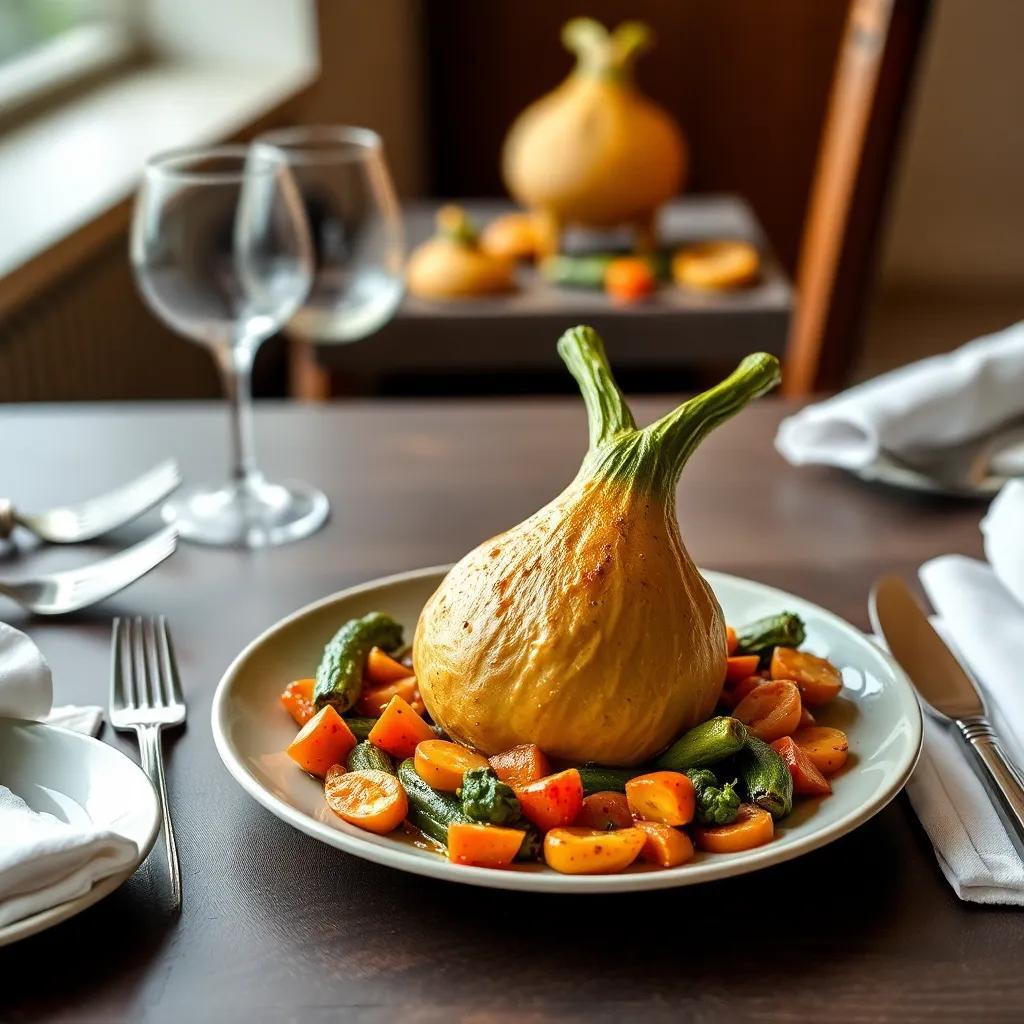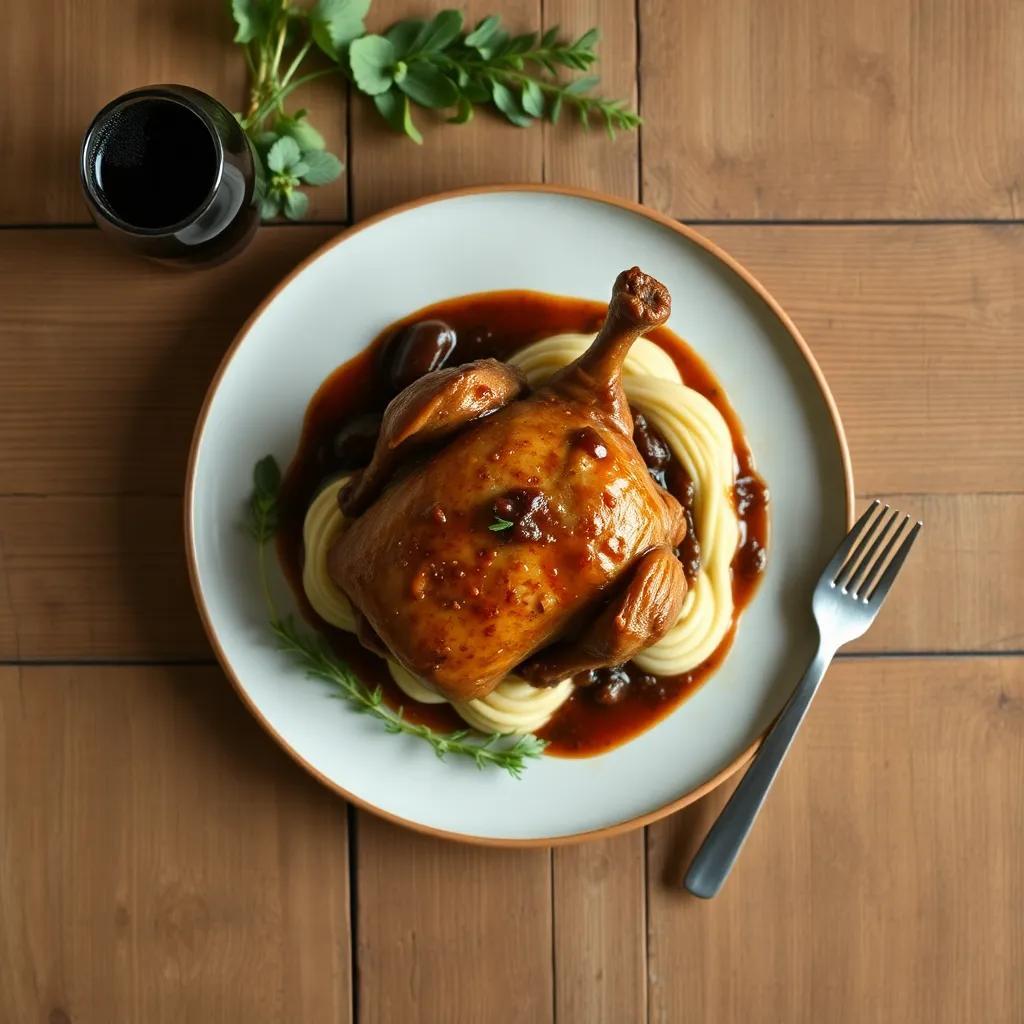Classic Boeuf Bourguignon Recipe: Rich, Tender & Irresistible
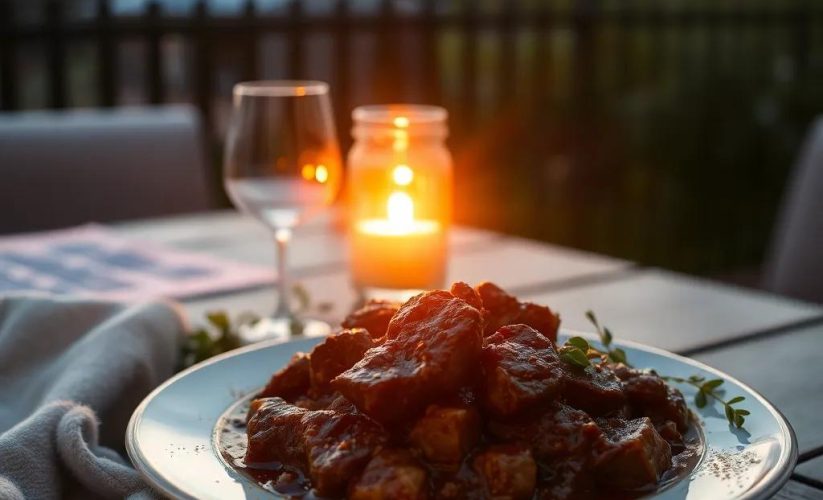
Classic Boeuf Bourguignon Recipe: Rich, Tender & Irresistible
🌍 Cuisine: French
⚙️ Difficulty: Medium
Ingredients
Nutrition Facts
550
Instructions
- Preheat your oven to 325°F (160°C).
- Pat the beef cubes dry with paper towels and season with salt and freshly ground black pepper.
- In a large heavy-bottomed Dutch oven or ovenproof pot, heat 2 tablespoons of olive oil over medium-high heat. Brown the beef cubes in batches, making sure not to overcrowd the pot. Remove and set aside.
- Add the diced bacon to the pot and cook until crisp. Remove and set aside with the beef.
- In the same pot, add the chopped onion and sauté until softened, about 5 minutes. Add garlic and cook for another minute until fragrant.
- Return the beef and bacon to the pot. Sprinkle flour over the meat and toss to coat. Cook for 2-3 minutes to remove the raw flour taste.
- Slowly stir in the red wine, scraping up any browned bits from the bottom. Add beef broth, tomato paste, and the bouquet garni. Bring to a simmer.
- Cover the pot with a lid and place it into the preheated oven. Cook for about 2 1/2 to 3 hours or until the beef is tender when pierced with a fork.
- While the beef cooks, heat 1 tablespoon butter and 1 tablespoon olive oil in a skillet. Sauté pearl onions until golden and tender, then set aside.
- In the same skillet, add remaining butter and sauté mushrooms until browned and their liquid evaporates. Set aside.
- When the beef is tender, remove the pot from the oven. Discard the bouquet garni. Stir in the sautéed mushrooms and pearl onions, simmer on the stove for 10 minutes to blend flavors.
- Taste and adjust seasoning with salt and pepper if needed.
- Garnish with freshly chopped parsley before serving.
- Serve hot, ideally with buttered noodles, mashed potatoes, or crusty French bread.
Serving Suggestions
- Serve over creamy mashed potatoes to soak up the rich sauce.
- Accompany with buttered egg noodles or wide pasta ribbons.
- Pair with a side of steamed green beans or sautéed kale for freshness.
- Offer crusty French baguette to dip into the flavorful sauce.
- Complement with a light green salad dressed in vinaigrette to balance richness.
- Enjoy alongside roasted root vegetables such as carrots and parsnips.
- For a traditional touch, serve with a glass of red Burgundy or Pinot Noir wine.
Table of Contents

Intro
There’s something truly special about a meal that invites lingering at the table, savoring each bite and sharing stories with loved ones. Classic Boeuf Bourguignon is one of those dishes—an elegant yet comforting French stew that fills your home with an inviting aroma and offers rich, tender morsels of slow-cooked beef that practically melt in your mouth. While it does require some time and attention, the process isn’t complicated, making this recipe a rewarding weekend project or a memorable dish for festive gatherings.
Perfect for cooler evenings or when you want to impress guests with timeless cuisine, this boeuf bourguignon transforms everyday ingredients into a luxurious experience. It’s the kind of dish that brings warmth—not only from its rich flavors but from the effort and care invested in making it. Whether you’re celebrating a special occasion or simply craving a hearty, soul-satisfying meal, this recipe promises to deliver a satisfying blend of tradition, comfort, and indulgence, turning your kitchen into a cozy French bistro in no time.
Ingredient Notes
When it comes to crafting an authentic and deeply flavorful Boeuf Bourguignon, a few key ingredients deserve special attention for their impact on taste and texture. Understanding these ingredients can elevate your cooking experience and ensure every spoonful carries the essence of classic French cuisine.
Beef Chuck: This cut is the hero of Boeuf Bourguignon. Known for its balance of marbling and connective tissue, beef chuck becomes irresistibly tender and succulent after slow braising. When shopping, look for well-marbled, bright red chunks that aren’t too lean—this fat renders down during cooking to create rich, juicy bites. If chuck isn’t available, a well-marbled beef brisket or round roast can work, but expect variations in tenderness and flavor intensity.
Red Burgundy or Dry Red Wine: Traditionally, Boeuf Bourguignon calls for Burgundy wine, which imparts a delicate earthiness and nuanced fruit character to the stew. Red wines with moderate tannins and good acidity—such as Pinot Noir, Merlot, or a blend from other dry reds—can be excellent stand-ins. Avoid overly fruity or oaky wines that might overpower the dish. When selecting wine, consider one you’d enjoy sipping, as the flavor will concentrate as it simmers.
Bouquet Garni: This fragrant bundle of thyme, parsley stems, and bay leaf acts like a subtle herbaceous backbone to the stew. Tied together, the bouquet infuses layers of aromatic complexity without overwhelming the dish. Fresh herbs are preferred, but dried thyme and bay leaf can substitute if fresh isn’t accessible. Just remember to remove the bouquet before serving to avoid unwelcome surprises in texture.
Pearl Onions: These sweet, tender little onions add both texture and subtle flavor that cut through the richness of the meat and sauce. If fresh pearl onions are hard to find, frozen versions are a convenient alternative and work beautifully when peeled ahead of cooking. As another option, small shallots or diced regular onions can be used, but the characteristic bite and sweetness of pearl onions are hard to replicate.
By appreciating these ingredients not just as checklist items, but as essential characters playing specific roles, you can better select quality components that honor tradition while fitting your pantry and palate. This mindful approach ensures your Classic Boeuf Bourguignon turns out as rich, tender, and irresistible as it promises.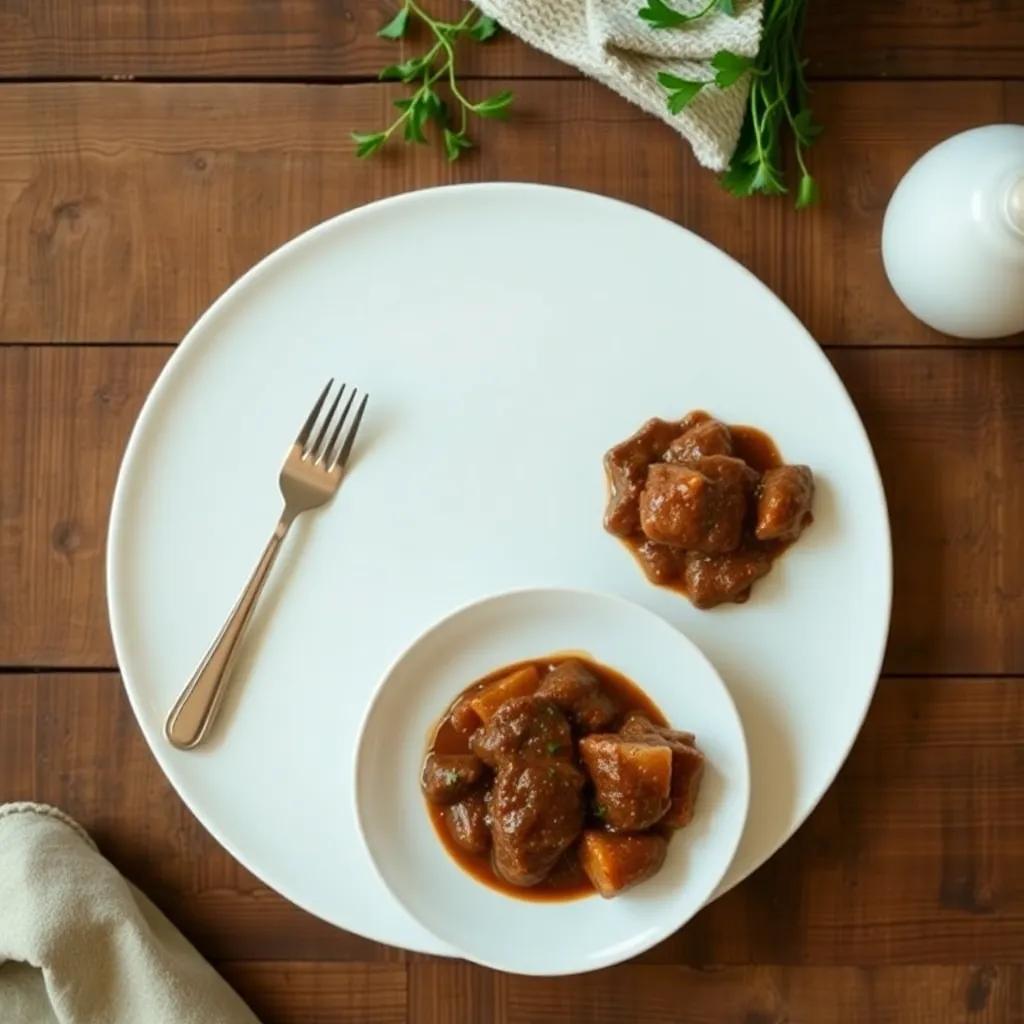
Tips & Variations
Mastering a Classic Boeuf Bourguignon is as much about patience as it is about technique—and a few well-chosen tweaks can make this French classic truly your own. Here are some tips and variations to elevate your stew, customize it to your tastes, or accommodate dietary preferences without losing the essence of its rich, comforting soul.
- Choose the Right Browning Method: Browning the beef cubes thoroughly over medium-high heat before braising isn’t just about color—those caramelized crusts develop deep, complex flavors through the Maillard reaction. Avoid crowding the pot; work in batches to ensure each piece sears properly. If you rush this step, the stew may lack that unmistakable depth of flavor.
- Wine Substitutions and Enhancements: While red Burgundy or Pinot Noir is traditional, don’t hesitate to experiment with other dry reds like Merlot or Cabernet Sauvignon, which offer bolder profiles. For a non-alcoholic version, substitute with a combination of unsweetened grape juice and a splash of red wine vinegar, or use a robust beef broth enriched with a bit of balsamic vinegar to mimic the acidity.
- Boost Umami with Additional Ingredients: To deepen the savory notes, consider adding a splash of soy sauce or a spoonful of miso paste during the simmering stage. These umami boosters blend seamlessly without overpowering the classic French flavors. For a smoky twist, a small amount of smoked paprika can add subtle warmth.
- Pearl Onion Alternatives: If pearl onions are unavailable, small shallots or chopped sweet onions can fill in, though the texture differs slightly. For easy peeling, blanch frozen pearl onions in boiling water for a minute, then transfer to ice water—the skins slip off effortlessly.
- Customization for Dietary Restrictions:
– Gluten-Free: Use a gluten-free flour blend or cornstarch slurry instead of all-purpose flour to thicken the sauce. Double-check that your stock and tomato paste contain no hidden gluten.
– Vegan Adaptation: Replace beef with hearty vegetables like king oyster mushrooms, seitan, or eggplant cubes for richness. Swap bacon for smoked tempeh or coconut bacon, and use vegan butter or olive oil. Replace beef broth with vegetable stock and omit the bouquet garni if it contains herbs not suitable for your palate, substituting with rosemary or sage as desired.
- Layer Flavor with Advance Prep: For an even richer profile, marinate the beef cubes in the wine with some herbs and garlic overnight in the fridge. This infusion unlocks subtle complexity even before cooking begins.
- Adjusting Cooking Times: Depending on your oven and the size of your beef chunks, cooking times can vary—start checking tenderness at the 2-hour mark and continue until the meat shreds easily with a fork. Slow-cooker enthusiasts can also prepare this dish by browning on the stovetop and then transferring to a slow cooker for 6-8 hours on low heat.
- Sauce Texture Tips: If your sauce feels too thin after cooking, remove the lid and simmer uncovered on the stove to reduce and thicken. Alternatively, swirl in a small knob of cold butter off the heat to enrich the sauce and give it a glossy finish.
- Serving Style Variations: While buttered noodles and mashed potatoes are classic accompaniments, try serving Boeuf Bourguignon over creamy polenta or a bed of steamed couscous for a modern touch. This can add a contrasting lightness to the hearty dish.
With these tweaks and substitutions, you can honor the spirit of Boeuf Bourguignon while making it fit seamlessly into your kitchen rhythm and dietary needs—each version promising that same irresistible, melt-in-your-mouth experience that makes this dish a timeless favorite.
Leftovers & Storage
After savoring your Classic Boeuf Bourguignon, you’ll find that the rich, slow-cooked flavors only deepen and mellow in the leftovers—making this dish an ideal candidate for meal prepping or enjoying on multiple occasions. To preserve its luscious texture and bold taste, proper storage is key.
Firstly, allow the stew to cool down to room temperature but avoid leaving it out longer than two hours to prevent bacterial growth. Transfer your leftovers into airtight containers—glass containers with tight-fitting lids work beautifully as they avoid retaining odors and can go straight from fridge to microwave or oven. Alternatively, heavy-duty freezer bags are great space-savers if you plan to freeze portions.
In the refrigerator, Boeuf Bourguignon keeps well for up to 3 to 4 days. When reheating, do so gently to avoid drying out the meat; warming on low heat in a covered pan helps maintain moisture and allows the sauce to loosen naturally. Adding a splash of beef broth or wine during reheating can revive the velvety sauce if it’s thickened too much.
For longer storage, freezing is an excellent option, especially if you’ve made a double batch. The stew freezes well for up to 3 months without significant loss of flavor or texture. Before freezing, cool completely, portion the stew into meal-sized containers, and label with date and contents. When ready to eat, thaw overnight in the fridge for best results and reheat slowly on the stove. Avoid microwaving straight from frozen to keep the meat tender and avoid uneven heating.
If you intend to pack Boeuf Bourguignon for work or travel, pick a sturdy container with a secure seal to prevent leaks. Keep it chilled until reheating and consume within 24 hours of packing. Because of its rich sauce and tender meat, it pairs beautifully with reheated mashed potatoes or simple buttered noodles for a satisfying portable meal.
In essence, the slow-simmered magic of Boeuf Bourguignon shines even brighter as leftovers. With mindful storage and reheating practices, you can enjoy this French classic’s deep, comforting flavors and tender bite days—or weeks—after the initial feast.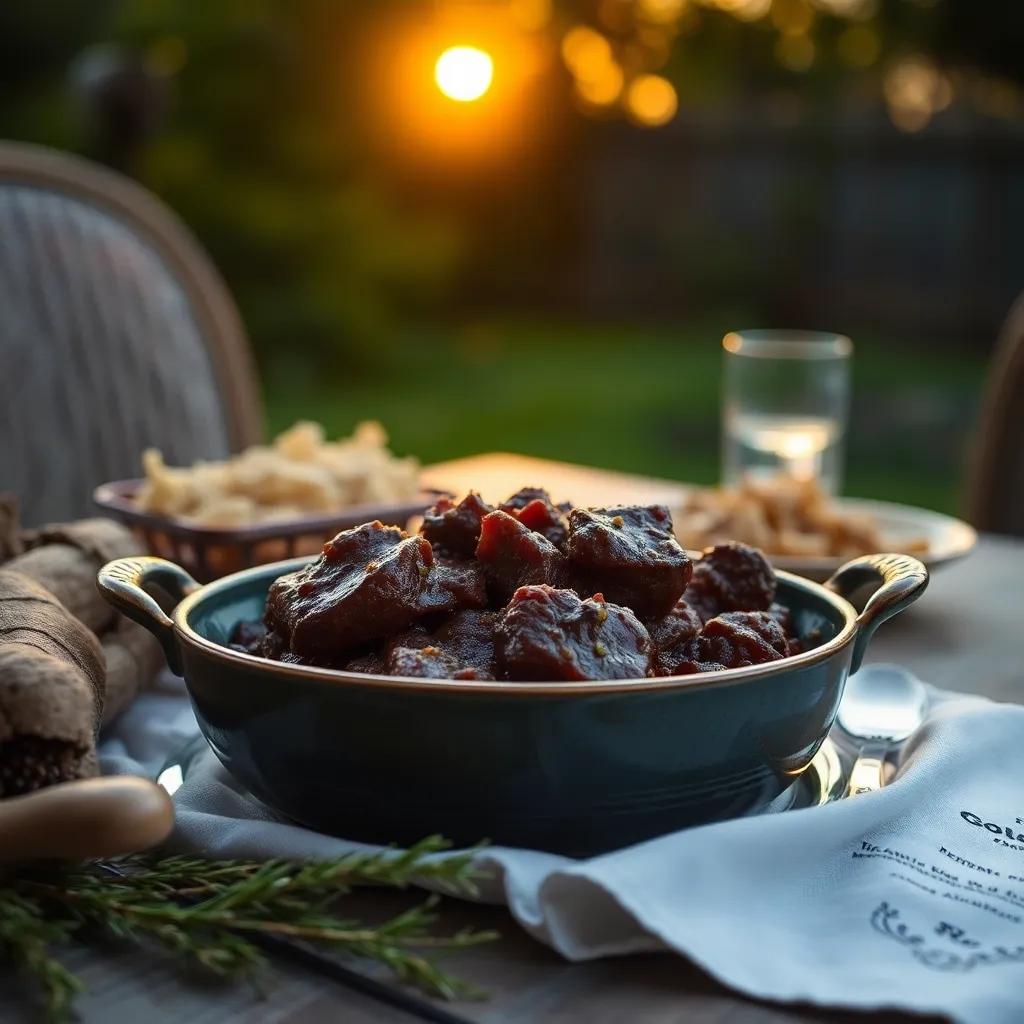
Behind the Recipe
Boeuf Bourguignon is much more than a recipe; it’s a culinary story steeped in history and tradition, reflecting the heart of French country cooking. Originating from the Burgundy region in eastern France, this dish was once humble peasant fare—a way to transform affordable beef and local ingredients, like the region’s famed red wine, into a nourishing, celebratory meal. Over time, it evolved into a beloved classic, symbolizing the rustic yet refined soul of French gastronomy.
The magic of Boeuf Bourguignon lies in its slow-cooked tenderness and the harmonious marriage of robust flavors—each element telling a story. The wine, harvested from Burgundy’s vineyards, lends a depth that speaks to the terroir and the region’s winemaking heritage. Meanwhile, the bouquet garni, a simple bundle of herbs, whispers secrets from the French countryside, infusing the stew with subtle natural fragrances.
In many French homes, this dish is linked to gatherings where time slows down—whether celebrating holidays, family reunions, or weekend dinners meant for lingering conversation. Its preparation encourages patience and care, a cooking ritual as valuable as the meal itself. Personally, many home cooks find that simmering Boeuf Bourguignon introduces a certain kind of calm; it’s a delicious meditation in the kitchen that rewards the cook and guests alike.
There’s also something wonderfully communal about this recipe. Because it improves with time, leftovers often taste better the next day, inviting shared meals that stretch beyond just one evening. The dish becomes a centerpiece of connection, evoking a sense of warmth and welcome that’s quintessentially French.
In embracing this recipe, you’re not just cooking—you’re stepping into a tradition that honors simplicity, patience, and richly layered flavors. It’s a dish that bridges generations and cultures, reminding us how food carries stories, memories, and a taste of place in every mouthful.
FAQ
Can I use a different cut of beef if I don’t have chuck roast?
Is there a vegetarian version of Boeuf Bourguignon?
How long can I store leftovers, and can I freeze Boeuf Bourguignon?
What’s the best way to reheat Boeuf Bourguignon without drying it out?
Can I make Boeuf Bourguignon in a slow cooker or Instant Pot?
What wine should I use if I can’t find Burgundy wine?
Can I prepare parts of the recipe ahead of time to save on cooking day?
Try It Yourself
There’s something timeless about a well-made Boeuf Bourguignon — its rich flavors and tender meat invite you to slow down and savor every bite. This classic recipe captures that comforting, hearty spirit, making it a perfect dish to share with loved ones or impress at your next dinner gathering.
If you decide to bring this delicious tradition to your table, we’d love to hear how it turns out! Feel free to leave a comment, rate the recipe, or share your own twist. After all, great cooking is all about making a classic your own. Happy cooking!










